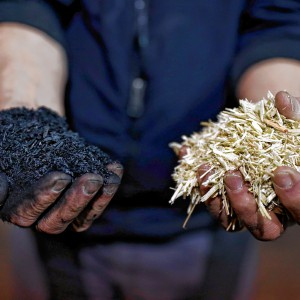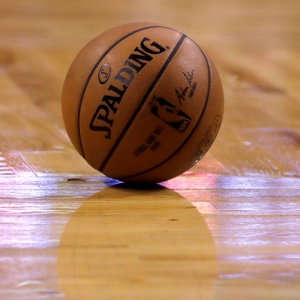High schools: Digging deeper into how the MIAA ranking formula fared this winter

The Pioneer boys basketball team stands during the anthem before playing New Mission in the MIAA Division 5 boys basketball state semifinal game at Worcester State University earlier this month. STAFF PHOTO/PAUL FRANZ
| Published: 03-29-2024 5:45 PM |
It’s always an interesting exercise to review the MIAA winter tournament brackets and see how the rating system fared in regard to ranking teams.
The MIAA says the rating system is simple and transparent, noting on its website “the benchmark is win/loss, margin of victory, and strength of schedule. League and division do not factor into the rating formula. The rating formula uses the variables of win/loss, MOV and SOS and produces a rating through iteration.”
How’d the rating system do with stacking teams this past winter season?
Let’s start on the courts. In terms of rating the top team in each division, the formula did its job. On the boys basketball side, four of the five state champions were the top overall seed, with second-seeded New Mission in Div. 5 the lone exception. On the girls side all five state champion basketball teams were the No. 1 seed.
Going back to the boys side, 58 preliminary round games were played this winter. Those are higher-seeded teams playing, and any team with 10-plus wins despite not being in the top 32 of the rankings. That would seemingly be ripe for upsets, but it wasn’t the case.
Of those 58 prelim games, the lower-seeded team (meaning better seeded) won 42 times. The upsets came in the higher divisions, as underdogs were 5-5 in both Div. 1 and Div. 2. Just one upset occurred in eight Div. 3 prelim games, favorites went 14-2 in Div. 4 while the lower seed went 11-3 in Div. 5.
How about in the Round of 32? There were 80 Round of 32 contests across the five divisions, with the lower-seeded teams going 72-8 in those games. One upset happened in D1, two in D2, one in D3, one in D4 and three in D5.
Underdogs did better in the Round of 16, but not by much. Of the 40 Round of 16 contests, lower seeds went 32-8, two upsets happening in D1, three in D2 and one each in D3, D4 and D5.
Article continues after...
Yesterday's Most Read Articles
 Carol Doucette of Royalston receives $15,000 from Publishers Clearing House
Carol Doucette of Royalston receives $15,000 from Publishers Clearing House
 Magic comes to Red Apple in Phillipston
Magic comes to Red Apple in Phillipston
 Plan calls for upgrades to Silver Lake in Athol
Plan calls for upgrades to Silver Lake in Athol
 Royalston’s FinCom debates proposed salary increases
Royalston’s FinCom debates proposed salary increases
 Locking up carbon for good: Easthampton inventor’s CO2 removal system turns biomass into biochar
Locking up carbon for good: Easthampton inventor’s CO2 removal system turns biomass into biochar
 Liberty Taphouse to open in Athol
Liberty Taphouse to open in Athol
As mentioned earlier, the semifinals and finals typically involved the teams expected to make it based on their ranking. Each No. 1 seed made the finals while four of the five No. 2 seeds reached the semifinals. Three of them advanced into the finals. In D1, the final four consisted of the 1, 2, 3 and 4 seeds. D2 had the must upset-laden final four (1, 4, 7, 14 seeds) while there weren't many upsets in D3 (1, 2, 3, 4), D4 (1, 2, 4, 6) and D5 (1, 2, 3, 5). Of the 20 final four squads, 16 of them were 1-4 seeds.
Tough to argue against those results on the boys side. How about the girls?
Starting in the prelims, lower-seeded teams went 33-8. Two upsets happened in D1, one in D2, none in D3, two in D4 and three in D5. In the Round of 32, lower seeds went 69-11 with one upset coming in D1, two in D2, three in D3, three in D4 and two in D5.
The seeds held strong in the Round of 16, with lower seeds going 34-6. One upset took place in D1, two in D2, two in D3, none in D4 and just one in D5.
Like the boys side, the final four was mostly comprised of top four seeds. The Div. 1 field was made up of the top four seeded teams, D2 had the most upsets (1, 5, 6, 7) while D3 (1, 2, 3, 5), D4 (1, 2, 3, 4) and D5 (1, 2, 4, 6) all nearly held form. Of the 20 final four teams, 15 were top four seeds.
No rating system is ever perfect. But, for one that must rank a team from Berkshire County against a team from the Cape that have no common opponents, the current rating system did about as good of a job as anyone could ask for based on the results on the court.
How about on the ice? The rating system wasn’t as flawless as it was in basketball, but that is also due to hockey being a more unpredictable sport. Being a lower scoring game where each goal is so meaningful, as well as the impact one goalie can make on a game, hockey is naturally going to have more upsets in a single-game elimination tournament than basketball.
On the boys side — which features four divisions — lower-seeded teams went 53-11 in the Round of 32 and 22-10 in the Round of 16. The upsets really happened in the latter stages of the tournament, as the final fours were littered with higher-seeded teams.
In Div. 1, the No. 1, 4, 11 and 18 seeds reached the semifinals. St. John’s Prep, the No. 1 seed, beat No. 11 Winchester in the finals. In Div. 2 the final four was comprised of the No. 1, 4, 10 and 11 seeds, with 11th-seeded Boston Latin winning the championship over top-seeded Tewksbury. Div. 3 saw the No. 1, 2, 6 and 12 seeds reach the semis, with sixth-seeded Marblehead beating No. 1 Nauset in the finals while in Div. 4, the 1, 5, 6 and 10 seeds made the semis, with fifth-seeded Dover Sherborn knocking off sixth-seeded Hanover in the championship game.
The girls hockey brackets held to form more than the boys’ did. In the Round of 32 the top-seeded teams went 28-4 and in the Round of 16, lower-seeded squads went 11-5.
In Div. 1, the 1, 2, 4 and 11 seeds reached the semis and in Div. 2, it was the 1, 2, 5 and 11 seeds. Both championship games were between the No. 1 and 2 seeds, with second-ranked St. Mary’s winning in D1 while top-seeded Duxbury took home the D2 title.
In all, there has been plenty of skepticism about how the rankings would work when the new system was put into place a few years ago. After the winter season, it seems they’re doing a good job of properly seeding the teams throughout tournaments.

 H.S. Roundup: Pioneer boys basketball pulls away from Hopkins
H.S. Roundup: Pioneer boys basketball pulls away from Hopkins  UMass basketball: Saint Joseph’s hands Minutemen another heartbreaking loss 78-77
UMass basketball: Saint Joseph’s hands Minutemen another heartbreaking loss 78-77 H.S. Roundup: Caleb Murray’s 20 points powers Greenfield boys basketball past Frontier (PHOTOS)
H.S. Roundup: Caleb Murray’s 20 points powers Greenfield boys basketball past Frontier (PHOTOS) Local Roundup: Big fourth quarter lifts Mahar girls basketball past Easthampton
Local Roundup: Big fourth quarter lifts Mahar girls basketball past Easthampton